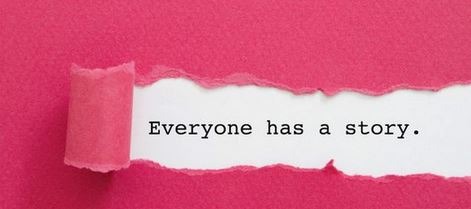 Turn Your Story into Leads and Potential Customers
Turn Your Story into Leads and Potential Customers
Think about all the emails and sales pages you’ve seen just in this last week, touting a new class, product, or service. Very often marketers will highlight the features and benefits of their latest creation but then fall short because they didn’t include a story. Here, I’ll share how to turn your story into prospects and clients.
The art of storytelling in business can be crucial to your success. It can mean the difference between having a sales funnel full of leads or barely staying alive because you’re connecting with the wrong people. People will spend their money with you only after then know, like, and trust you. What better way to build that relationship than with your storytelling skills.
Connect with the Right People
Of course, your storytelling skills are wasted unless you identify your ideal clients and where to find them. Think too broadly and you’ll attract freebie seekers or others who will request a price reduction. Or you’ll find those who can afford your price point but who don’t want to do the work. Narrow your sights on your ideal client and create a storyboard with their demographics. Where do they live? Are they married? Do they have a family? How old are they? What are their pain points? How can you help them?
By stating these specifics, you will paint a clear picture of who you want to help, who you want to attract into your funnel, and where you can find them to start interacting. Focus on building relationships instead of selling products. Not everyone you meet will be ready to buy or maybe they are just on the fringes of your ideal market and not the right fit. Keep growing your network and you will find your tribe who will hang on your every word and will trust your judgment enough to make purchases.
Make Your Connections Personal with Stories
Your audience wants to connect with YOU, not with your product. What more personal way to make a connection than with a story, or two. Your customers or clients want to know your history, why did you start your business, and how can you help them. How are you different from all the other coaches out there? What is your inspiration? What personal struggles have you overcome?
Yes, at some point they will want to know about the features of your product and how it can help them but start off by allowing your audience to know you. Show your human side by telling your stories on video. They don’t have to be as polished or as lengthy as a TED talk but you’ll be surprised how many people prefer video over reading outrageously long sales pages.
Show your human side; don’t edit out all your flubs. What better way to portray yourself as human than to show some bloopers. Showcase your expertise but show your tribe that you’re accessible by answering questions and asking them directly what kind of help they need.
When you decide to connect on a human level instead of always pushing a sale, people will naturally be attracted to you and will want to learn more about you and your business. Be patient; relationship building takes time but the sales will follow.
Just remember… approach these new connections with the idea of building a relationship and of showing a legitimate interest in their business or their life. You’re planting the seed, if you will, of what you do and who you help, so at some point down the road, the seed will sprout and these people will turn to YOU when they are ready for your help.
Do You Have an Offline Marketing Plan?
With millions upon millions of people using the internet every single day, it’s very easy as a coach to get caught up in how to market your business online. But offline marketing is equally important for your business success and shouldn’t be ignored. The two factions really should work hand in hand for ultimate success.
Build Those Relationships
Marketing your coaching business in real life isn’t much different than doing it online except you’re not hiding behind a computer screen. This idea can be extremely intimidating, especially for introverts, but the more you practice your real life interactions, the easier it becomes.
One tip to remember: Marketing does not equal sales. Marketing is about building relationships or planting seeds about your business so when the time is right, a prospect will remember your name and contact you. You do not need to be in a constant state of selling; answer questions about your business but also ask questions to learn more about your contact’s businesses. You won’t truly know if you can help each other without listening to what they do.
Local Networking Events
Begin searching for local networking groups or events. Many groups, such as BNI, allow visitors to attend meetings free of charge so ask about that option. After one or two visits, you’ll know if the group will be beneficial to you; if so, join up. If not, search for your local Chamber of Commerce, small business meetups, or other professional networking groups. Use the same criteria for joining local groups as you would for joining Facebook or LinkedIn groups: who is in the group; how you can contribute in a meaningful way; and how will the group benefit you?
Find Local Sponsorship Opportunities
Many local organizations or charities look for sponsors to keep their programs running. Check out your Little League or other youth sporting clubs to sponsor a team or purchase an ad in their outfield. Look for youth theater groups – or even drama clubs in different schools – and pay for an ad in their playbills. Ask if your local places of worship have a weekly bulletin that accepts advertisements. Be smart with your choices; ultimately you still want to target your ideal clients but paying it forward in your community will also bring about some name recognition.
Participate in Community Days
Does your town or those surrounding you have Community Days? Ask about setting up a booth to showcase your business. Print some pamphlets and business cards to hand out. Better yet, create an inexpensive swag bag with your printed material inside, along with a treat for those who stop by your booth. Remember to visit the other vendors and introduce yourself, much like you would at a networking event. Sometimes vendors will become your clients, all because they met you at a local event.
In the end, interacting with your local community and business owners is much like interacting with online followers. Be helpful, be attentive, and be visible to naturally attract clients.
Refine Your Marketing Message
Knowing your ideal audience is important but knowing what they struggle with will help you refine your marketing message even further. Now you can narrow your market even more by telling them how you can help, once you identify those pain points.
Want the Secret to Finding Your Ideal Clients’ Struggles?
Tips for Crafting Your Story – Turn Your Story into Prospects and Clients
People are naturally drawn to stories. Audiences spend millions of dollars in the movie theaters, engrossed in a good storyline. Millions of novels are sold to those who want to jump into a fantasy world in an effort to follow an exceptional plot. The popular “This Is Us” television show had sky high ratings every week because we grew to love the Pearson family through their individual stories.
Chances are high that even if you didn’t watch “This Is Us” you know all about it from the commercials and people talking about it, still today. This is the effect of telling compelling stories with characters that you grow to love. THIS is what you’re aiming for with your own stories.
Stories can be powerful if you know how to grab your audience’s attention. You have a short amount of time to pique their interest but then it takes much more effort to keep them interested. It’s quite easy for me to say, “Tell a story to connect with your ideal audience,” but where do you begin? Do you start from the day you were born and continue through your awkward middle school years? Most likely not. First, you need to create a plan, then you need to decide which details and how many details are warranted.
Storytelling Tips to Turn Your Story into Prospects and Clients
1. Make your story compelling. Do you have a “hook” that will catch your audience’s attention right away?
2. Know the purpose of your story. Don’t just talk for the sake of talking. Point out the connection before your audience gets bored and questions why they’re spending time listening.
3. Use vivid descriptions and strong words. Avoid passive voice or sounding wishy washy. Avoid using too many statistics. Instead, paint a striking picture in the minds of your audience to draw them deeper into the story.
4. Don’t brag; connect instead. While your accomplishments may be impressive and will set you apart from the vast majority, don’t bore your audience with them. Keep these impressive feats on your resume. When telling your story, relate to your audience by telling them about all the times you messed up. Every one messes up so that’s a common thread among all of us. How you came out of your mess is what will impress your audience.
5. Connect emotionally. Decide which emotion you want to tap into during your story and provide information to your audience that will elicit that emotion. People will remember you better if you add emotion to your story. Think of all those times you cried at those sappy romance movies.
6. Avoid coming across as Ferris Bueller’s boring teacher. OK, this is a throwback from the ‘80s but in the movie “Ferris Bueller’s Day Off,” his teacher has the most monotone voice in the world. You can imagine just how awful it must be to sit in his classroom after just hearing a moment of his dialogue. Avoid this at all cost! You want to engage your audience, not bore them and make them run for the doors.
7. Give your audience what matters. Learn to edit the details to avoid putting them into a boredom trance. You’re not fabricating anything, you’re simply picking and choosing wisely which details to share and which to keep locked up. This is how to turn your story into prospects and clients.
You’ll notice that these tips progress naturally from grabbing their attention to making a connection to providing a satisfying conclusion. With some tweaking and practice, you’ll have your story perfected and ready for the audience.
If Your WHY Doesn’t Make You Cry, It’s Not Big Enough
I’m really not sure who coined this phrase but I’ve heard it multiple times over the years, across multiple different industries, and it holds significant truth. WHY did you start your business? WHY do you want to be a coach? WHY do you get up every single day and work? You can turn your story into prospects and clients by fleshing out your WHY and sharing it with others.
Everyone should have a WHY and there are no right or wrong answers here. But if you find yourself unmotivated to work or if you want to procrastinate on projects, then it’s time to re-examine the main reason for your business.
Name Your Reason – or Your WHY – for Starting a Business
Focusing on your WHY can help motivate you so write down your reason for starting a business. Did you want to fill your free time? Did you want to earn some play money or contribute to the family finances? Did you want to pay the medical bills of an aging parent or a sick child? Did you want to pay for your child’s higher education or private school tuition?
Writing these reasons down – no matter what they are because every person’s WHY will be different – should help motivate you to work hard. You should feel driven to make your business a success. You should be willing to tackle things outside your comfort zone because you know the end result will help your business.
If you’re not feeling motivated, then you need to dig deeper.
Don’t be Afraid to Examine Your Inner Feelings to Turn Your Story into Prospects and Clients
Life is fluid and ever-changing so it stands to reason that your WHY would change over time as well. Even if you started your business because you didn’t know what to do once your kids were in full day school, you can change that WHY to something more meaningful now.
A mentor once shared that she started a service business because she was a single mom and needed to earn money to survive. She was responsible for lodging, food, and clothing for herself and her child. She didn’t have anyone to rely on except herself. THIS is enough to make you cry and to hustle for work, knowing that if she wasn’t working, she wasn’t eating.
What are you passionate about that will get you hustling? Are you passionate about a cause or charity that can benefit from your financial assistance? Do you need to pull yourself up out of financial despair? Don’t be afraid to own that reason and fight for your business. You may even want to start blogging about these topics, so others may read and respond.
Don’t be Afraid to Switch Business Gears as You Turn Your Story into Prospects and Clients
One of my clients told me that even though she has been in a service business for 10 years that she hasn’t been motivated to create any classes or products as a source of passive income. She blames her indecision for that but I questioned if it was because she didn’t feel attached to that particular industry. After some more discussion, she agreed and has since modified her services that align better with what she enjoys. I still suggested that she explore a deeper WHY but this is a step in the right direction.
Plenty of businesses add or subtract products or services or modify their mission statement. If something about your business doesn’t feel right, don’t be afraid to make changes. And the place to begin is by embracing the concept of how to turn your story into prospects and clients.
Explore How Your Story Can Grow Your Business
People know me for my story of how I worked as a classroom teacher for twenty years, while simultaneously working as a real estate broker and residential appraiser. I made the decision to leave it all behind and come online in 2006 to start my business. You can easily turn your story into prospects and clients by being completely transparent as to where you are coming from. Make it a goal in your business, and it may increase your productivity as well.
I’m bestselling USA Today and Wall Street Journal author Connie Ragen Green, embracing storytelling, productivity, and goal setting to create a lifestyle by design and a business that most people only dream about. Yes, you can turn your story into prospects and clients by following what I’m sharing here and making it your own.






Leave a Reply